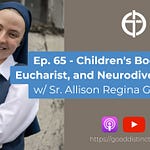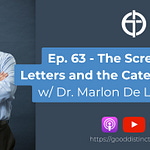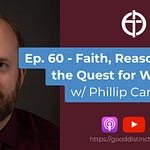NOTE: THIS EPISODE WAS PUBLISHED BEFORE OUR REBOOT. willwrightcatholic.com is now gooddistinctions.com
Introduction
Today we are exploring one of the most important topics in human history: the Incarnation of the Word of God. What we celebrate on the Solemnity of the Annunciation and then nine months later on December 25th is the most marvelous of mysterious miracles. What does the Church definitively teach about the Incarnation? What is the Hypostatic Union? Is Jesus half-God and half-man or fully God and fully man? How does that work? What are some of the heresies about Christ?
This week’s episode will exclusively focus on the fact, nature, and truth of the Incarnation. There is far more to say about the nature of Christ than I can cover in one short episode. So, know that there is more to say, more distinctions to draw, and more fruitful reflection to be had! Next week, in a second part, we will explore the effects of the Incarnation on Christ Himself as well as the teaching of St. Thomas Aquinas on the fittingness of the Incarnation. As well, we will look at the effects of the Incarnation on humanity and the world. In other words, what is the significance of Christmas for you and I personally?
The Marvelous Fact of the Incarnation
Two thousand years ago, the Eternal Word of God took on Flesh. In the Nicene Creed, Christians acclaim that: “For us men and for our salvation he came down from heaven; by the power of the Holy Spirit, he became incarnate of the Virgin Mary, and was made man.” Belief in the Incarnation of the Son of God, the second Person of the Blessed Trinity, is distinctively Christian.
No other religion claims something so seemingly outlandish: that the Almighty God would condescend to share in His creation. Yet, this is the truth. The Incarnation is a marvelous fact, a “unique and altogether singular event (CCC 464)” to borrow the language of the Catechism.
This marvelous reality is not simple to understand, nor is it something intuitively grasped by our feeble human intellect. However, there is much that God has revealed to us and unpacked through the guidance of the Holy Spirit over the centuries. The “Incarnation is… the mystery of the wonderful union of the divine and human natures in the one person of the Word (CCC 483).” We will walk through the Divinity of Jesus Christ then His human nature, and then we will be able to talk with some level of clarity on the Hypostatic Union.
I am going to try hard to keep this simple without watering anything down. I will also try to define any technical terms that I use. My hope is that this will remain accessible while faithful and accurately explaining the Church’s perennial teachings on the nature of the Incarnation.
The Divinity of Jesus Christ
Two thousand years ago, Jesus of Nazareth was conceived and born, a real person of history. Historical consensus confirms this reality. We also have the faithful witness of the Old and New Testaments. In the Old Testament, the Psalms, the Wisdom Literature, and the Prophets all speak of the coming Messiah. The Jewish people at the time of Jesus were waiting for the Messiah, an anointed one, who would take the throne of King David and rule as a militaristic warrior to expel the Romans from the Holy Land.
In the New Testament, St. Matthew traces the genealogy of Jesus back to Adam and St. Luke traces the genealogy of Jesus back to God Himself. St. Matthew’s genealogy also particularly centers Jesus as the expected heir of David’s throne. From the perspective of today, we, of course, know that Jesus did not come as a militaristic warrior-king. But, how do we know that Jesus Christ is God, that He is Divine?
In the beginning of the Holy Gospel according to St. John, there is no genealogy. Instead, the prologue of John identifies Jesus with the uncreated Word of God through which all things were made: the Logos. The Word of God has become man and pitched His tent among us. He is the Emmanuel foretold by the Prophet Isaiah. The Gospels firmly show that Jesus is not merely another anointed one (messias), He is the Divine Messiah (cf. Mt. 1:23, 2:6; Mk. 1:2, Lk. 7:27). He is God’s own Son (cf. Mt. 16:13; Jn. 10:36; Mk. 14:62; Lk. 1:35). And, finally, He is God. “In the beginning was the Word and the Word was with God and the Word was God… (cf. Jn. 1:1).”
There is a phenomenal exploration of the claim to divinity of Jesus in the New Testament by Dr. Brant Pitre entitled: The Case for Jesus: The Biblical and Historical Evidence for Christ. I highly recommend reading that book, if you are interested!
The remainder of the New Testament further solidifies the Divinity of Jesus Christ and this fact is upheld by the Fathers of the Church in the first millennium of the Church as well. By a singular miracle, the uncreated Son of God, consubstantial with the Father was made man and dwelt among us. He is, thus, truly and appropriately called a Divine Person. As the Council of Chalcedon in 451 A.D. put it:
“We confess that our Lord Jesus Christ is not parted or divided into two persons, but is one and the same only-Begotten Son and Word of God (Chalcedon, Part ii, act. 5).”
Modern academics of all stripes will try to poke holes in the doctrine of the divinity of Christ. This makes sense for those who wish to conform God to their viewpoint rather than be conformed by Him. If Jesus Christ is God, then everything He said carries the full authority of Almighty God.
The Human Nature of Jesus Christ
Jesus Christ is fully God. But Jesus Christ is fully man, with flesh supplied from the womb of the Blessed Virgin Mary. He is a Divine Person, not a human person. However, He possesses a full and complete human nature: body and soul. As St. Thomas Aquinas puts it: “Although Christ is not the human nature, He has human nature (ST III, q. 10, a. 10, ad. 1).”
The human nature of Christ is difficult to wrap our minds around. Some in the history of the Church, for example, have tried to claim that Jesus’ human body was an illusion. To this, St. Augustine answers:
"If the Body of Christ was a fancy, then Christ erred; and if Christ erred, then He is not the Truth. But Christ is the Truth; hence His Body was not a fancy' (Augustine, QQ. lxxxiii, q. 14; P.L., XL, 14).”
Just as we acknowledge wholeheartedly that Jesus Christ is truly God, we also acknowledge that a true human soul animates the truly human body of Jesus. St. Thomas Aquinas explains:
“The body is not said to be animated save from its union with the soul. Now the body of Christ is said to be animated, as the Church chants: ‘Taking an animate body, He deigned to be born of a Virgin’ [Feast of the Circumcision, Ant. ii, Lauds]. Therefore in Christ there was a union of soul and body (cf. ST III, q. 2, a. 5, s.c.).”
The Hypostatic Union
Fully God and fully man, Jesus Christ is the God-Man. The central mystery within the mystery of the Incarnation is how the divinity and humanity of Jesus interact. This mystery is called the hypostatic union. Hypostasis is the Greek word for person. St. John Damascene teaches that “In our Lord Jesus Christ we acknowledge two natures, but one hypostasis composed from both (De Fide Orth. iii, 3, 4, 5). The Catholic Encyclopedia explains of this union:
“We speak here of no moral union, no union in a figurative sense of the word; but a union that is physical, a union of two substances or natures so as to make One Person, a union which means that God is Man and Man is God in the Person of Jesus Christ (CE).”
St. Thomas Aquinas speaks at length about the nature of the hypostatic union, but one insight that I find most helpful is the difference between assumption and uniting. He speaks of assumption as an action - the Word of God assumed human flesh. This is not wrong to say, but St. Thomas prefers the idea of uniting or becoming. The Word of God became flesh or united with the human flesh of Jesus at His first moment of existence.
Here we can already run into problems if we are not careful. Did Jesus have a beginning? Yes! Did the Son of God have a beginning? No! He is begotten, not made, eternal and consubstantial with God the Father. As St. Thomas concisely explains:
“Whatever has a beginning in time is created. Now this union was not from eternity, but began in time. Therefore the union is something created (ST III, q. 2, a. 7, s.c.).”
There is a true union of divinity and humanity in Christ. But we should not think that the divinity of Christ overpowers and consumes the humanity of Christ. Pope Alexander III, in the 12th Century, quipped: “Since Christ is perfect God and perfect man, what foolhardiness have some to dare to affirm that Christ as man is not a substance?" In other words, the metaphysical substance of the human nature of Christ is real and persists, completely and perfectly united to His divine nature.
How did this happen? How were the divinity and humanity of Jesus Christ united, in time? It is by God’s grace! It is a true miracle, a unique and singular event. St. Thomas Aquinas echoes St. Augustine when he teaches:
“Augustine says (De Praed. Sanct. xv): ‘By the same grace every man is made a Christian, from the beginning of his faith, as this man from His beginning was made Christ.’ But this man became Christ by union with the Divine Nature. Therefore this union was by grace (ST III, q. 2, a. 10, s.c.).”
False Natures of the Incarnation - Heresies about Christ
There is no shortage of false teachings about Jesus Christ. Catholic orthodoxy is a thin line which has been guarded as a precious jewel from apostolic times. Without the authentic measure of orthodoxy provided by the Catholic Church, then any opinion would be fair game. In fact, this is unfortunately the state of affairs in many Protestant communions.
Before we further clarify what the Catholic Church teaches truly about Jesus Christ, it is helpful to look at some of the heresies about Christ in the early Church. By looking at what the incarnation is not, we can come to a better understanding of what it is. There is a lot to be said about these heretics and heresies, but I am going to try to keep it brief.
Arianism
Arius was a priest in Constantinople in the late 3rd Century and early 4th Century. He believed that God the Father was uniquely God and Christ was subordinate in every way to the Father. He denied the hypostatic union and believed that Christ was the highest of the creatures of God. No small historical issue, there was a time when the majority of the Church’s episcopacy was Arian in belief.
Suffice it to say, Catholic orthodoxy was victorious. The Council of Nicaea in 325 A.D., led by the great Saint Athanasius formulated the first version of the Nicene Creed that is professed on Sundays. We believe in “one Lord Jesus Christ… true God of true God… Who took Flesh, became Man and suffered.”
Nestorianism
In 428 A.D. the Patriarch of Constantinople was a man named Nestorius. He called the union of the two natures a mysterious and an inseparable joining, but would admit no unity in the strict sense of the word to be the result of this joining. The union of the two natures, to Nestorius, is not physical but moral. As he put it “the Word indwells in Jesus like as God indwells in the just.” There is not a true, physical and lasting union of divinity and humanity. To explain his view he said that Mary is the Mother of Christ (Christotokos) but not the Mother of God (Theotokos)
Nestorius denied the hypostatic union but, unlike Arius before him, did acknowledge the divinity of Christ. He just did not believe that there was a physical union or substantial union of humanity and divinity. So, to Nestorius, when Christ suffered, He did so in His humanity, not in His divinity.
On the contrary, Saint Athansius taught (against Apollinarius) that:
“They err who say that it is one person who is the Son that suffered, and another person who did not suffer ...; the Flesh became God's own by nature [kata physin], not that it became consubstantial with the Divinity of the Logos as if coeternal therewith, but that it became God's own Flesh by its very nature [kata physin] (Contra Apollinarium, I, 12, in P.G., XXVI, 1113).”
The Council of Ephesus in 431 A.D. condemned Nestorius as a heretic and defined that Mary was mother in the flesh of God’s Word made Flesh. In this way, it is right to call her Theotokos or God-bearer. The specific anathema against Nestorianism was written by St. Cyril of Alexandria who wrote extensively on the nature of Christ. He said:
“If in the one Christ anyone divides the substances, after they have been once united, and joins them together merely by a juxtaposition [mone symapton autas synapheia] of honour or of authority or of power and not rather by a union into a physical unity [synode te kath henosin physiken], let him be accursed (can. iii).”
Monophysitism
The Christological heresies, so-called, did not end with the Council of Ephesus. Eutyches took part in that Council of Ephesus and was fiercely opposed to the teachings of Nestorius. However, he went too far in the other direction. He developed the heresy of Monophysitism which held that there was only one Person in Christ (which is true) but he only held one nature in Christ (which is heretical). His denial was that Christ was “consubstantial with us men” as St. Cyril of Alexandria held. Eutyches was stressing Christ’s uniqueness, not intended to deny Christ’s full manhood. The error of Eutyches is the cautionary tale of not swinging too far in our refutations.
This heresy was condemned by the Council of Chalcedon in 451 A.D. It was formulated in this way:
Jesus Christ remained, after the Incarnation, “perfect in Divinity and perfect in humanity… consubstantial with the Father according to His Divinity, consubstantial with us according to His humanity… one and the same Christ, the Son, the Lord, the Only begotten, to be acknowledged in two natures not intermingled, not changed, not divisible, not separable (cf. Denzinger, n. 148).”
Monothelitism
The next heresy of monothelitism began orthodox enough. The monothelitists defended the union of two natures in one Divine Person. They went off the rails in saying that this Divine Person only had one divine will - they denied the human will of Jesus.
Sacred Scripture teaches us that Jesus Christ has a human will. He performed acts of adoration, humility, and reverence. In the Garden of Gethsemane, He prayed to the Father that the “cup” of His sacrifice and death pass without His drinking it. Praying to the Father in this way, He showed His human aversion to death but also the human act of the will of obedience in saying: “not my will, but thine be done.”
Monothelitism was condemned by the Third Council of Constantinople in 680 A.D. They defined that in Christ there were two natural wills and two natural activities, the Divine and the human, and that the human will was not at all contrary to the Divine, but rather perfectly subject thereto (cf. Denzinger, n. 291).
The Truth About the Incarnation - Catholic Teaching
By way of summary, what then does the Church authentically teach about the nature of Christ and the hypostatic union? Jesus Christ is a Divine Hypostasis - a Divine Person. The unique hypostatic union of Jesus Christ is the complete union of two natures, one divine and one human, in one Divine Person without change, division, separation, or the like.
When the Eternal Word of God took Flesh, there was no change in the Word. All the change that took place was in the Holy Flesh of Christ. At the moment of conception, in the womb of the Blessed Mother, through the forcefulness of God’s activity, the human soul of Christ was created and the Word became the man that was conceived.
Next Time on WWC
Next time on WWC, we will explore the second part of this series on the incarnation. Namely, we will be looking at the effects of the Incarnation on Christ Himself, on the world, and on us! We will also look briefly at what St. Thomas Aquinas had to say on the fittingness of the Incarnation. For example, if mankind had not sinned, would God have still become incarnate?! Stop on by next time and see what the Angelic Doctor had to say. The next part of the series should also be a fruitful reflection for us entering into Christmas! Thanks for reading. See you next time on Will Wright Catholic!












